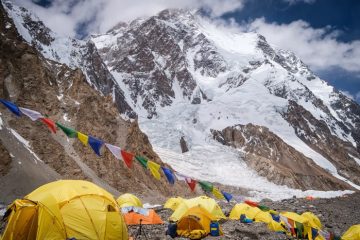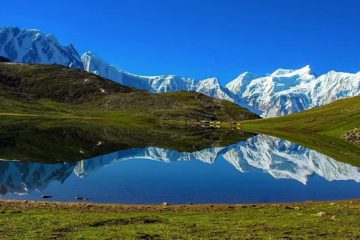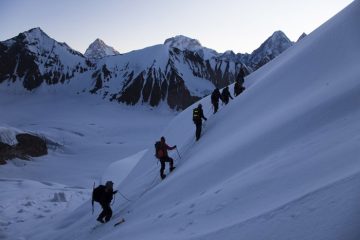Hunza Batura Trek – Explore the Untouched Wilderness of Pakistan’s Majestic Glacier Valley
The Hunza Batura Trek is one of Pakistan’s most scenic and rewarding trekking adventures, taking you deep into the heart of the Upper Hunza Valley, home to the legendary Batura Glacier—the fifth-longest glacier outside the polar regions. Stretching over 57 kilometers, this massive glacier offers breathtaking landscapes, tranquil alpine meadows, and uninterrupted views of snow-covered peaks including the Batura Massif, Passu Sar, and Shispare Peak.
Starting from the picturesque Passu village in Gojal, Upper Hunza, the trek winds through traditional Wakhi settlements, peaceful yak pastures, and along the lateral moraine of the glacier. This moderately challenging trek is ideal for those seeking raw natural beauty, cultural interaction, and an off-the-beaten-path trekking experience in Gilgit-Baltistan, Pakistan. The route includes enchanting spots like Yunzbin, Yashpirt, Guchesham, and Lupdor, offering panoramic vistas and a rare chance to camp in high-altitude grasslands, where wildflowers bloom and yaks roam freely.
The Batura Trek is less commercialized than other treks in the Karakoram, making it a hidden gem for nature lovers and photographers. You’ll be rewarded with views of towering peaks, the mighty Batura Glacier, and the famous Passu Cones that dominate the skyline of Hunza. Along the way, trekkers encounter herds of yaks, ibex, marmots, and an array of alpine flora and fauna. The region’s unique Wakhi culture and warm hospitality add rich cultural depth to the trekking experience.
Best undertaken from June to September, the Hunza Batura Glacier Trek requires basic trekking experience and good physical fitness. While the trail doesn’t involve technical climbing, you’ll need to navigate rocky paths, glacial streams, and high-altitude terrain. Hiring local guides and porters from Passu is recommended for a safe and immersive journey.
This trek is not only about adventure—it’s about reconnecting with nature in one of the world’s most untouched mountain landscapes. Whether you’re a seasoned trekker, a landscape photographer, or simply someone looking to experience the serene beauty of Northern Pakistan, the Batura Trek offers a once-in-a-lifetime escape into the wild.
Why the Batura Glacier trek should be on your bucket list
The Batura Glacier sits in the rugged Batura Muztagh — the westernmost subrange of the Karakoram — and is one of the longest non-polar glaciers on Earth. It drains a dramatic wall of 7,000–7,800 metre giants including Batura Sar (7,795 m) and nearby peaks such as Passu and Shispare, creating jaw-dropping panoramas and raw high-mountain terrain you won’t find on more crowded trails. If you love long moraines, glacial rivers, high alpine pastures and views of towering, serrated peaks, this is a pure Karakoram experience.
Hunza Batura Trek — Key facts at a glance
-
Region: Upper Hunza (Gojal), Gilgit-Baltistan, Pakistan.
-
Glacier length: The Batura Glacier extends roughly 50–58 km, making it one of the largest non-polar glaciers in the Karakoram.
-
Highest peaks visible from the trek: Batura Sar (≈7,795 m), Passu Sar, Shispare and others.
-
Typical trek duration (from base access points): 6–10 days of trekking embedded in a 9–13 day door-to-door trip from Islamabad. Tour packages commonly run 8–12 days.
-
season: mid-June to late September — long daylight, milder mountain temperatures, and clearer passes.
-
Difficulty: Moderate to strenuous — long trekkking days over moraines and steep trails, possible glacier travel, and high altitude (camps often around 3,000–4,500 m). Local guide and porter support strongly recommended.
How to reach Hunza Batura Trek (step-by-step from Islamabad)
There are two common approaches to reaching the Batura/Batura Glacier area from Islamabad: overland by the Karakoram Highway (KKH) or a combination of flight + drive (seasonal / weather dependent). Both approaches are used by tour operators and independent travellers.
1. Overland (recommended for scenery & flexibility)
-
Islamabad → Karimabad / Hunza (by road): The drive follows the Karakoram Highway (KKH) north through Abbottabad, Besham, Chilas, and Gilgit. Expect ~600 km and 12–16 hours of driving from Islamabad to Hunza by private car (times vary with conditions), often split into two driving days for comfort. The KKH is spectacular and offers views of Rakaposhi and many Karakoram peaks along the way.
-
Hunza (Karimabad/Gulmit/Passu) → Trekheads: From Karimabad or Passu, local jeeps (4×4) transport you upside valley or to the trailhead (Passu–Yunzben–Batura valley routes). Many itineraries use Passu as the staging point for the Batura approach.
2. Fly + drive (time-saving, weather-sensitive)
-
Islamabad → Gilgit (domestic flight) — flights operate seasonally and can cut many hours off the road transfer. From Gilgit you drive 1.5–3 hours to Karimabad / Passu depending on flight and road conditions. Note: flights are subject to cancellations due to mountain weather.
Important practical notes:
-
The Karakoram Highway is the main artery; road travel gives unrivalled mountain views and is preferred by photographers and acclimatizers.
-
Carry and present valid ID (passport for foreigners, CNIC for Pakistani nationals); foreigners may need a NOC or registration depending on the itinerary and proximity to border areas — your operator will handle permits.
Hunza Batura Trek highlights — what you’ll remember forever
-
Batura Wall & Batura Sar panorama — an immense serrated ridge with summits topping 7,700–7,800 m. Perfect for alpine photographers.
-
Vast moraines and glacial landscapes — the lower Batura’s debris-covered ice and braided meltwater channels create surreal, lunar-like scenery.
-
Local mountain villages & culture — stay in Hunza hamlets like Gulmit and Passu, taste local apricot and walnut products, and meet Balti/Gojali communities.
-
Less crowded, off-the-beaten-track atmosphere — far fewer trekkers than the Baltoro/Broad Peak routes; a quieter, more exploratory feel.
-
Karakoram Highway drive — the road itself is a highlight, with high mountain vistas and classic Karakoram photography stops.
Safety, permits & local logistics
-
Permits & registration: Depending on the exact route and proximity to international borders, foreign trekkers may require an NOC or registration. Your tour operator will arrange necessary permits and local government requirements.
-
Guides & porters: Glacier travel and moraine crossings require local knowledge; hiring a licensed local guide, cook, and porters is strongly recommended.
-
Altitudes: Highest camps may approach 4,000–4,500 m; plan for gradual acclimatization days and watch for altitude sickness. Carry Diamox only under doctor’s guidance.
-
Weather & contingencies: Mountain weather can close flights and make KKH sections slow; always build buffer days into your itinerary.
Hunza Batura Trek essentials — Packing & checklist
Mandatory: trekking boots (broken in), insulated sleeping bag (to −10°C or lower depending on month), waterproof jacket, warm layers (down jacket), trekking poles, headlamp, sunhat, sunglasses (UV rated), high SPF sunscreen, water purification (tablets/filters), personal first-aid & altitude medication plan, copies of ID & permits.
Useful: gaiters, crampons (only if you expect to step onto clean ice — operator will advise), crampon-compatible boots if glacier travel is planned, lightweight tent (if not provided), dry bags, thermos, power bank, spare batteries, handwarmers.
Food & water: operator usually supplies meals on multi-day treks; bring high-energy snacks and electrolyte powders.
Documents: passport (foreigners), CNIC (Pakistani nationals), emergency contact numbers, travel insurance that includes medical evacuation and trekking above 3,000 m (recommended).
Photography & responsible trekking
-
Use lightweight cameras or mirrorless systems; drones may be restricted — check local regulations and always ask locals before flying.
-
Respect local customs and dress modestly in villages. Keep plastic and waste with you; pack out non-biodegradable trash. The Karakoram is fragile — practice Leave No Trace.
Pricing & booking considerations
Package prices vary widely based on group size, included services (jeep transfers, porters, cooks, tents), and whether flights are used. Expect realistic pricing to reflect local guides’ wages, transit times on the KKH, and quality of camping equipment. Compare operator itineraries for included services, group size limits, and safety protocols.
Frequently Asked Questions
Q: What is the best time to trek Batura Glacier?
A: Mid-June to late September — stable weather, milder days and optimal high-alpine access.
Q: How long is the Batura Glacier?
A: Approximately 50–58 km, one of the largest non-polar glaciers in the Karakoram.
Q: Do I need a guide?
A: Yes — glacier and moraine travel plus local permit logistics make a certified local guide and porter strongly recommended.
Q: Can I fly to Gilgit to shorten travel time?
A: Yes — domestic flights can shorten overland time, but they’re weather dependent and sometimes canceled; allow buffer days.
Why choose Pakistan Tours Packages for the Hunza Batura Trek (our promise)
If you’re deciding between operators, here’s why travelers trust us:
-
Local, licensed guides with deep Karakoram experience
Our lead guides are licensed, born and raised in Gilgit-Baltistan, and know every contour of the Batura Wall and its safe approaches. They manage weather, route-finding and local relations so you can focus on the view. -
Safety-first protocols
We carry full-first aid kits, oxygen and evacuation plans, and have established evacuation contacts across the Hunza region. We monitor weather and road conditions daily and build contingency days into every plan. -
Authentic local support & fair employment
We hire local porters, cooks and drivers at fair wages, improving local livelihoods and giving you an authentic cultural exchange. -
Small groups, tailored pace
We cap group sizes so the pace suits everyone — whether you’re a fit hiker or a first-time multi-day trekker. Personalised pacing reduces altitude-related issues. -
Transparent pricing & no hidden fees
Our quotes list what’s included (meals, tents, porters, permits, transfers); any optional extras are shown upfront. We’ll help with visas, NOCs, or special dietary needs. -
Sustainable & responsible travel
We follow Leave No Trace, support local conservation drives, and reduce single-use plastics on every trip. -
Photography & experience maximization
We plan stops for optimal light, sunrise/sunset viewpoints and photo-ops of the Batura Wall and Karakoram skyline.
Final travel tips
-
Train with long hikes and a loaded daypack before departure.
-
Break in your boots and test sleeping systems.
-
Carry phone numbers for your embassy (if applicable) and local emergency contacts.
-
Always keep a small cash reserve — remote areas may not accept cards.
-
Consider travel insurance that covers helicopter evacuation and high-altitude trekking.
| DEPARTURE/RETURN LOCATION | Islamabad, Islamabad | ||||
| WEAR | Comfortable clothing, hiking boots, hat, jacket and sunscreen. | ||||
| INCLUDED |
|
||||
| NOT INCLUDED |
|
Day 1: Islamabad – Chilas (via Naran/Babusar OR Besham/KKH)
-
Travel Time: 12–14 hrs
-
Option 1: Islamabad – Naran – Babusar Top – Chilas (summer only)
-
Option 2: Islamabad – Besham – Dassu – Chilas (year-round via KKH)
-
Overnight: Hotel in Chilas
Day 2: Chilas – Passu (Upper Hunza)
-
Drive along Karakoram Highway
-
Sightseeing: Rakaposhi Viewpoint, Attabad Lake, Gulmit
-
Arrive in Passu village – base for Batura trek
-
Overnight: Guesthouse in Passu
Day 3: Rest & Acclimatization in Passu
-
Explore Passu village and surroundings (Passu Glacier, Hussaini Suspension Bridge)
-
Light walk and local cultural interaction
-
Overnight: Guesthouse in Passu
Day 4: Trek Begins – Passu to Yunzbin
-
Trek time: ~5–6 hrs
-
Easy start along the Batura Glacier’s lateral moraine
-
Camp near Yunzbin
-
Overnight: Tent camping
Day 5: Yunzbin to Yashpirt
-
Trek time: ~5–6 hrs
-
Beautiful alpine pastures, views of Passu cones and Shispare
-
Camp in Yashpirt meadow (shepherd huts, grazing yaks)
-
Overnight: Tent camping
Day 6: Yashpirt to Guchesham
-
Trek time: ~5 hrs
-
Deeper into the Batura Valley, lush grazing fields
-
Camp near Guchesham (Batura glacier’s central viewpoint)
-
Overnight: Tent camping
Day 7: Guchesham to Lupdor / Batura Viewpoint
-
Trek time: ~3–4 hrs
-
Day hike to Lupdor for panoramic views of Batura Peaks and the glacier
-
Return to Guchesham or camp near Lupdor
-
Overnight: Tent camping
Day 8: Rest or Exploration Day
-
Optional hike around glacier or resting day
-
Enjoy high-altitude scenery, wildlife (ibex, marmots)
-
Overnight: Tent camping
Day 9: Trek Back – Guchesham to Yashpirt
-
Retrace your steps with different scenic views
-
Trek time: ~5 hrs
-
Overnight: Tent camping
Day 10: Yashpirt to Passu
-
Final descent to Passu village
-
Trek time: ~6 hrs
-
Overnight: Guesthouse in Passu (hot shower, rest)
Day 11: Passu – Karimabad (Hunza Valley)
-
Short scenic drive (~1.5 hrs)
-
Visit Altit & Baltit Forts, Duikar viewpoint for sunset
-
Optional visit to Hopper Glacier (if time allows)
-
Overnight: Hotel in Karimabad
Day 12: Karimabad – Chilas (via KKH)
-
Long scenic drive back toward Islamabad
-
Break at Rakaposhi viewpoint and Junction Point of 3 Great Mountain Ranges
-
Overnight: Hotel in Chilas
Day 13: Chilas – Islamabad
-
Drive via Naran/Babusar or Besham/KKH
-
Arrival in Islamabad by evening
-
Overnight: Hotel in Islamabad (or rest at home)
Day 14: Buffer/Rest Day in Islamabad
-
Use this day for rest, local sightseeing, or in case of delays
-
Optional visits: Faisal Mosque, Lok Virsa, Daman-e-Koh







